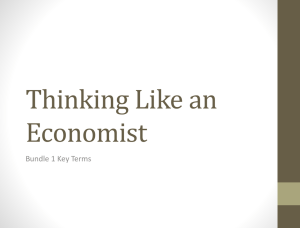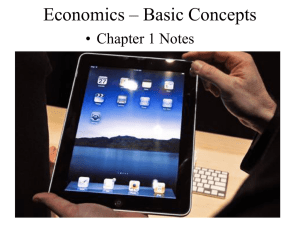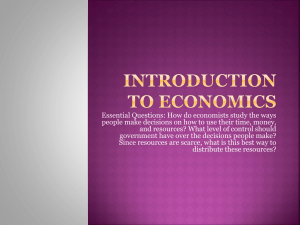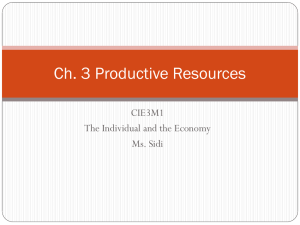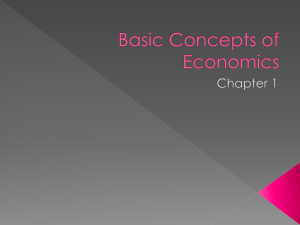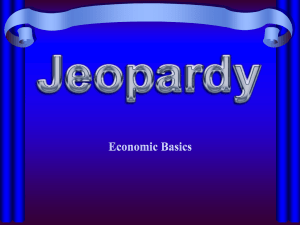WHAT IS ECONOMICS ALL ABOUT? 1. Introduction
advertisement
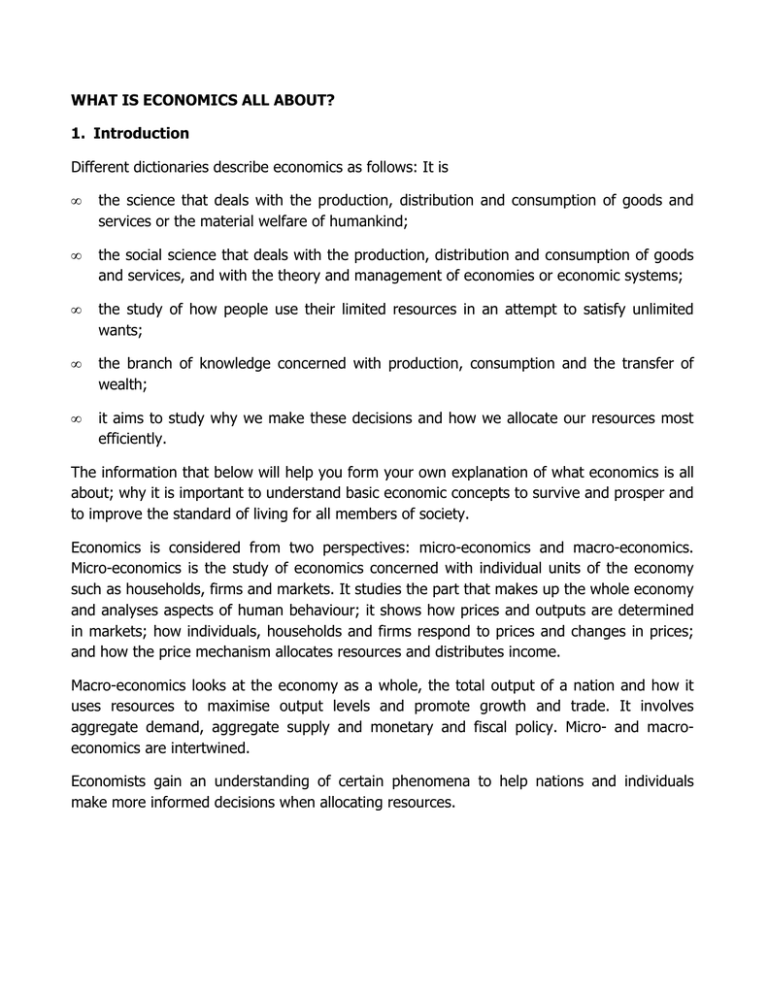
WHAT IS ECONOMICS ALL ABOUT? 1. Introduction Different dictionaries describe economics as follows: It is • the science that deals with the production, distribution and consumption of goods and services or the material welfare of humankind; • the social science that deals with the production, distribution and consumption of goods and services, and with the theory and management of economies or economic systems; • the study of how people use their limited resources in an attempt to satisfy unlimited wants; • the branch of knowledge concerned with production, consumption and the transfer of wealth; • it aims to study why we make these decisions and how we allocate our resources most efficiently. The information that below will help you form your own explanation of what economics is all about; why it is important to understand basic economic concepts to survive and prosper and to improve the standard of living for all members of society. Economics is considered from two perspectives: micro-economics and macro-economics. Micro-economics is the study of economics concerned with individual units of the economy such as households, firms and markets. It studies the part that makes up the whole economy and analyses aspects of human behaviour; it shows how prices and outputs are determined in markets; how individuals, households and firms respond to prices and changes in prices; and how the price mechanism allocates resources and distributes income. Macro-economics looks at the economy as a whole, the total output of a nation and how it uses resources to maximise output levels and promote growth and trade. It involves aggregate demand, aggregate supply and monetary and fiscal policy. Micro- and macroeconomics are intertwined. Economists gain an understanding of certain phenomena to help nations and individuals make more informed decisions when allocating resources. 2. Scarcity The balance between limited and unlimited is important when you think of economics. LIMITED UNLIMITED RESOURCES WANTS Society’s economic wants by far exceed the available resources. Economic wants are unlimited while resources are limited. The challenge remains to reach the fine balance between the unlimited wants and the limited resources. This challenge is referred to as scarcity and it refers to this tension between our unlimited needs and wants and the limited resources. As individuals we satisfy our needs, wants and desires by consuming goods, services or leisure activities. We experience scarcity in terms of a lack of resources to obtain everything we want (it can include skills, time, goods and services). Countries experience this scarcity by not having enough resources such as land, minerals, factories, equipment or skilled workers to produce enough goods and services to satisfy all the needs of its inhabitants. The limitation of resources compared to wants and needs forces individuals, as well as countries, to make decisions on what goods and services they can have and what they must sacrifice. This introduces the economic trio which is the basis of all economics: SCARCITY DECISIONS COST For example, if you choose to buy one expensive brand fashionable shirt as opposed to two cheaper T-shirts from an in-store brand, you must give up owning a second shirt less fashionable in exchange for the more fashionable brand shirt. Individuals use different criteria to make decisions and although all sacrifice things and experience costs, the cost will not be the same, as the value they allocate to certain goods or services differ. Every individual and nation has different values, preferences and tastes and will therefore make decisions based on different criteria. As we have different levels of resources, people and nations are faced with particular scarcities and will therefore develop different values regarding resources. All decision involves cost. In every decision you make you have a first choice and other choices that you gave up. The best next alternative you gave up when scare resources force you to use resources for one use rather than another purpose is called opportunity cost, because we gave up the alternative to use the resource for the other purpose. If you decide to use an ingredient to make a pizza rather than a pie, the pie is the opportunity cost. It is called opportunity cost because we gave up the alternative to use the resource for the other purpose. Opportunity cost refers to the best alternative you gave up - your second choice if there are more than two alternatives. An alternative is one of many choices or courses of action that might be taken in a given situation. Trade-off costs and benefits A trade-off means giving up one benefit or advantage in order to gain another regarded as more favourable. Individuals make trade-offs by sacrificing time for recreation and using that time to work longer hours and earn a higher income. They use that higher income to purchase more goods en services that give them satisfaction. Evaluating trade-offs means considering the costs and benefits of the available alternatives. One person can value the cost of having time for recreation now as more than the benefits of having extra money to buy more goods and services later. Such a person will do a trade-off between recreation time now and more money later to buy things with. Society also makes trade-offs, for example between its need for a cleaner environment and its desire for more power from a coal power-station that causes pollution. During trade-offs people usually make a cost/benefit analysis that is a process of examining the advantages (benefits) and disadvantages (costs) of each available alternative to arrive at a decision. A benefit is a monetary or non-monetary gain received because of an action taken or a decision made. Costs are an amount that must be paid or spent to buy or obtain something, or it is the effort, loss or sacrifice necessary to achieve or obtain something else. Productive resources Resources are used to produce the required goods and services that enable us to survive and prosper. These resources are called productive resources or factors of production and can be divided into three categories: natural resources, human resources and capital resources or capital goods. Natural resources are referred to as gifts of nature - things we use but cannot produce ourselves, such as land, water, sun, minerals and trees. Raw materials used in production come from natural resources, e.g. wood used to make furniture is a raw material that comes from trees, a natural resource. Human resources are the workers, also refer to as labour, that includes the special skills, experience, knowledge, and the physical and mental ability of people to participate in the production of goods and services. People invest in themselves and in others to improve their human capital. It is an investment of time, effort and resources in education and training to increase their own skills, knowledge, health and experience to be better workers producing higher quality goods and services. An entrepreneur is a person who assumes the risk of organising productive resources to produce goods and services. Capital resources are tools and equipment that are human-made and used to produce other goods and services. This includes things like buildings, tools, machines, factories and productive equipment. Capital goods differ from consumer goods, as consumer goods satisfy economic want directly; capital goods do it indirectly as capital goods are used to produce final consumer goods. Although money is invested to obtain and improve these capital resources it must not be confused with financial capital or money capital. Capital resources in economics to not refer to money. Money is simply a means for purchasing real capital. The study of economics therefore includes an explanation of how productive resources are used to produce goods and services to satisfy human economics wants. Because of scarcity, people and economies must make decisions on how to allocate their resources. Resources could be allocated by using different methods such as bidding or selling. To sell a product, a price must be allocated in the market place. People sometimes confuse price allocation as the only indication of scarcity. The prices of goods only indicate how scarce the goods are relative to other goods. A product with a high price can be scarcer than a product with a low price, but it is also possible that something with a low or no price allocation can be rendered as scarce. It is hard to think of anything not being scarce. One could argue that the salt in sea water, the air we are breathing at the moment or oil in Russia is not scarce, but for a scuba diver air is limited, desirable and therefore scarce. Although there are vast amounts of oil available in Russia, oil is still scare as the use of crude oil remains desirable; it is limited across the world and can be sold to other countries that do not have this natural resource; and it could be used for more than one valuable use. Scarcity is a relative condition, not absolute. Things are not scarce only when they are limited in quantity – they must also be desirable and have more than one valuable use. Although price could indicate relative scarcity, it could also indicate a shortage in this specific product or service. A shortage of petrol can be eliminated by an increase in price, but the natural resource from which petrol is produced, namely crude oil, is always scarce because it is limited, desirable and has many valuable uses. Garbage will not be regarded as scare because it is not desirable. Many people think water is not scarce because 71,11% of the earth consists of water. In fact, water is a scarce resource as only 3% of the water sources are fresh and fresh water is desirable, limited and has many uses (in the agricultural and industrial sector as well as in households for drinking, cooking, bathing and gardening). The fact that scarcity is relative can best be illustrated by the following example: if 15 learners share one pizza they will experience a scarcity of pizza. If the same learners have to share 150 pizzas there will still be scarcity as the resources that were used to make the pizzas could be used to produce something else. The allocation of resources could take place in one of the following ways: • willingness and ability to pay, by amount of cash, goods or services willing to be sacrificed • voting, majority rule • personal characteristics, by age, by weight or by alphabetical names • performance based, by test scores, quantity of sales, number of push-ups • first come first served, by who is first in line • fate, teacher's favourite or dictator's choice A combination of any of the above, such as willing and able to pay for a final popular soccer match and being first in line. 3. The Economic Problem It is clear that both individuals and societies are faced with THE ECONOMIC PROBLEM: How to make choices because economic wants are unlimited, but the means (income, time, resources) for satisfying those wants, are limited. Individual budget constraints or budget line best depict the cost of certain choices during the decision-making process. The following example best illustrates this idea. Suppose you and your five friends are going to watch the soccer match between Orlando Pirates and Bloemfontein Celtic. Your parents give you R25 to spend on refreshments for your friends. The money you do not spend you must hand back to your parents. A box of popcorn costs R2,50 and a bottle of fruit juice costs R5,00. The table below shows all the possible combination that you can buy: Number of boxes of popcorn 10 8 6 4 2 0 Number of juices Popcorn cost Juice cost Total cost 0 1 2 3 4 5 25 20 15 10 5 0 0 5 10 15 20 25 25 25 25 25 25 25 Quantity of popcorn Unattainable Quantity of bottles of juice The budget line illustrates various important issues: • • • • Possible combinations: All possible combinations of popcorn and juice are on or inside the budget line. One can buy 7 boxes of popcorn at R17,50 and 1 bottle of juice and still be within the budget. Although you can afford to buy 7 boxes of popcorn and 3 juices, you would rather spend the total R25. You cannot buy 2 boxes of popcorn for each of your friends because that is unattainable – the R25 limit simply does not allow you to do that. Trade-offs and opportunity cost: The budget line also illustrates the trade-offs. If you want to buy 3 bottles of juice for your friends to share, you have to give up 6 boxes of popcorn. The opportunity cost for 1 extra bottle of juice is two boxes of popcorn and that remains the same for each bottle of juice. Choice: Limited income, human capital or resources force people to choose what to buy and what to give up. Income changes: If you dad have given you only R10, your choices would be different. To increase your possible choices you need to change your income. That explains the fact that people want more income. But even if you have much more income, you still face trade-offs and choices and that involves opportunity costs. Just as individuals need to make decisions to solve their problem of limited income, time and resources, society needs to answer the following three basic questions: • • • What goods and services to produce? How to produce these goods and services? Who will consume the goods and services? 4. Decision-making Processes Decision making is defined as reaching a conclusion after considering alternatives and their results. People normally use an informal decision-making process. During this informal process people calculate the costs and benefits of certain options to make a final choice. The use of a formal decision-making grid normally helps people to evaluate their alternatives and make their final choice. A decision-making grid is a graph-like chart into which people can enter notations about the costs and benefits of various alternatives. The rows in the grid represent the alternatives or different options (including doing nothing) and the columns represent the different criteria. Criteria Weights: Alternatives 1 Alternatives 2 Alternatives 3 Alternatives 4 1 2 3 4 5 6 Total A musician is about to replace his car. He needs one that can not only carry all his instruments, including a set of drums and a tuba, but will also be good for business travel. He has always loved sports cars. No car he can find is good for all three things. His options are: • A 4x4, double-cab vehicle • A comfortable 'family sedan • A 2-door small city car • A convertible sports car The important issues he must consider are: • Cost • Ability and space to carry a musical instrument • Comfort over long distances • Able to be used during business trips and promote business image • Fun! • Nice look and quality built car. He must first draw up the table shown in Figure 1 and score each option by how well it satisfies each factor: Figure 1: Example Grid Analysis Showing Unweighted Assessment of How Each Type of Car Satisfies Each Factor Cost Space Comfort Business trips Fun Looks Total Sports Car 1 0 0 1 3 3 8 Double cab 1 3 2 2 1 1 10 Family Car 2 2 1 3 0 0 8 2-door small city car 2 1 1 2 0 1 7 Factors Weights Next he determines the relative weights for each of the factors. He multiplies them by the scores already entered and totals them. This is shown in Figure 2: Figure 2: Example Grid Analysis Showing Weighted Assessment of How Each Type of Car Satisfies Each Factor Factors: Cost Space Comfort Business trips Fun Looks Weights: 4 5 1 2 3 3 Sports Car 4 0 1 2 12 12 31 Double cab 4 20 0 4 3 3 34 Family Car 8 10 1 6 0 0 25 2-door small city car 8 5 1 4 0 3 21 Total This gives an interesting result: Despite its lack of fun, a station wagon may be the best choice. If the musician still feels unhappy with the decision, perhaps he has underestimated the importance of one of the factors. Perhaps he should give 'fun' a weight of 7 and buy an old station wagon to carry his load! The PACED decision-making model supports people in using the economic way of thinking by applying criteria when considering the cost and benefits of every alternative. This way of thinking prepares individuals for their roles as citizens and voters. P - Problem: Identify the problem A - Alternatives: List the alternatives C - Criteria: Identify and weight criteria E - Evaluation of criteria D - Decision making 5. Productivity People satisfy their economic wants by consuming goods, tangible objects and services, activities by other people. These people are called consumers. The ones producing the goods and services are called producers. Producers use productive resources (also called input) to produce goods and services (also called output). The cost of production is the amounts paid for resources (land, labour, capital and entrepreneurship) used to produce goods and services. INPUT NATURAL RESOURCES HUMAN RESOURCES CAPITAL REOURCES OUTPUT Production GOODS & SERVICES Productivity = An increase of productivity occurs if you produce more output for the same input or the same output with less input. Both the quantity and the quality must be considered when comparing productivity. The optimal use of productive resources is essential for an increase in productivity. Cost comparisons of all input costs must be considered if the productivity comparison studies are done. The effects of scarcity could be managed if productivity is increased. Productivity can be increased by the following factors: • • • • Specialisation and division of labour: Specialisation occurs when a company produces a narrow range of goods and services. Individuals, businesses and countries can apply specialisation. A doctor specialises in producing medical consultation services to patients. He does not try to do his own financial statements. He rather uses an accountant who specialises in providing financial consulting services to do his financial statements. The doctor and accountant can exchange services with each other to get what they want. If the doctor only focuses on providing medical consultations, he can become more productive than if he tried to produce both services. Specialisation in labour refers to different people having different occupations and the special skills to do those jobs, e.g. hairstylist, nurse, plumber and typist. The concept of division of labour relates to specialisation. It allows workers in an assembly line or a production line to do only a small part in the production process. All forms of specialisation increase productivity. The benefits of specialisation are increased productivity and increased trade. The costs are reduced self-sufficiency and increased economic interdependence. Technological change is improvements in a business’s ability to produce because of improved production processes, production methods and machines. This can be done by: o modifying products or inventing new products o reorganising the production process, such as faxing directly to a computer and not to a fax machine o the introduction of improved or innovative capital goods, e.g. the use of computers to improve production. Investment in capital resources/goods means that savings are used to finance the construction of new factories and machines or better tools and production equipment. If workers have access to adequate production stock and equipment, they can be more productive. Capital goods are normally very expensive but can last for a long time. The investment in capital goods is very risky. If a company upgrades electronic devices, these devices can become outdated before they have generated enough income to pay back the investment. Investment in human capital through education: If workers have better health, skills, knowledge and experience, they can deliver more output and use less input so that they become more productive. Firms and individuals who have invested time and money in more education and training usually become more skilled, get better job opportunities, earn more and get more job satisfaction. Investments in both human capital and capital goods incur opportunity costs as the money and resources used to make these investments can be used for various other uses. The costs for attending any training course involves not only the direct cost of the course; it also includes the indirect costs of what that person can produce in that time. It is important to note that investments in human capital and capital goods have significant risks and opportunity costs, but also provide the possibility to increase productivity tremendously. Effects of increased productivity Increased productivity allows individuals to earn more income and to increase their satisfaction levels because they can obtain more goods and services. It also provides benefits to society as it reduces scarcity and increases the standard of living. It is however important to note that scarcity cannot be eliminated by increased productivity. 6. Production Possibilities Model Production Possibilities Curve/Production Possibility Frontier (PPF) The PPF represents the points at which an economy is most efficiently producing its goods and services. At these points it is allocating its resources in the most efficient way. The PPF shows there are limits to production because of scarcity. This fact forces the economy to make choices between possible combinations. Imagine an economy that can produce only wine and cotton. Points A, B and C all appear on the curve and represent efficient use of resources in the choice of combinations. Point X represents an inefficient use of resources, while point Y represents choices that the economy cannot make at this stage, because they do not have enough resources. For this economy to produce more wine, it must give up some of the resources it uses to produce cotton (point A). If it starts producing more cotton (points B and C), it would have to divert resources from making wine and, consequently, it will produce less wine than it is producing at point A. If more wine is in demand, the cost of increasing its output is proportional to the cost of decreasing cotton production. When the PPF shifts outwards, we know there is growth in an economy (more of both products can be produced). Alternatively, when the PPF shifts inwards it indicates that the economy is shrinking. 7. Economic Systems Economic systems are the framework of formal and informal rules that a society uses to determine what to produce, how to produce and how to distribute goods and services. Economic systems can be categorised according to who makes most of the decisions in an economy. The market economy is an economy that relies on a system of interdependent market prices to allocate goods, services and productive resources and to coordinate the diverse plans of consumers and producers, all of them pursuing their own self-interest. The ‘invisible hand’ determines how resources should be allocated. The command economy is an economy in which most economic issues of production and distribution are resolved through central planning and it relies on the government to decide how the country's resources would best be allocated. Traditional economy is an economy in which customs and habits from the past are used to resolve most economic issues of production and distribution. The systems by which nations allocate their resources can be placed on a spectrum where the command economy is at one end and the market economy is on the other in terms of decision-making powers. In a market economy, most of the decisions in the economy about what to produce, how to produce it and who receives it are made by individuals and firms. At the other end of the spectrum, in a command economy, government officials make most of the decisions in the economy about what to produce, how to produce it and who receives it. Most economies are mixed in that some economic decisions are made by individuals and private firms, but some are also made by government officials, either through rules and regulations or through government-owned firms (for example, Eskom). Another way to classify economies is to look at ownership of key resources or private property. A system where resources belong to government or the state will be known as a socialist system; at the other end is a system where all resources are privately owned, called capitalism. 8. Markets and Prices Scarcity forces all societies to determine how they will allocate scarce resources. The command economy uses a centralised system to do this; the market economy relies on a price system for this. A market is a mechanism that brings buyers and sellers together. The market conveys the message of the decisions made by buyers and sellers of products and resources. A market economy is characterised by voluntary exchange and prices are signals or guides. If the media emphasise the importance of a healthy lifestyle, consumers will purchase more vitamin supplements. The market will respond to the higher demand for supplements and an increase in the price of vitamins will be the result with a higher profit for the producers of vitamin supplements. The rise in profits will encourage more producers to enter the market, so the supply of vitamins increases and the price drops again. It is important to realise that there is a interdependence between producers and consumers. 9. Circular Flow The movement of output and income from one sector of the economy to another is often illustrated as a circular flow diagram. The diagrams show how the market works, how money, goods and services and productive resources flow. It indicates the roles of firms/businesses and households, as well as the functions of financial markets and government. PRODUCT MARKET R/c R/c GOODS AND SERVICES HOUSEHOLDS BUSINESSESS PRODUCTIVE RESOURCE R/c FACTOR MARKET R/c PRODUCT MARKET R/c R/c GOODS AND SERVICES BUSINESSESS FINANCIAL CAPITAL MARKET R/c HOUSEHOLDS Bank Securities PRODUCTIVE RESOURCE R/c FACTOR MARKET R/c Productive Services Productive Services FACTOR MARKETS R/c RESOURCE OWNERS GOVERNMENTS BUSINESSESS / FIRMS MONEY PAYMENTS (SALES OR INCOME) Finished Goods &Services PRODUCT MARKETS Finished Goods &Services 10. Supply and Demand Demand It is the quantity of a product or service that buyers are willing and able to buy at all possible prices during a period of time. When prices increase and income stays the same, people will buy less of this product. They will even buy another similar product. An example is red meat and chicken. If the price of red meat increases a lot, people will buy more chicken. The lower demand for red meat will in its turn lead to lower prices for red meat. Supply It is the amount of a product or service that producers are willing and able to offer for sale at every possible price during a given period of time. When prices increase, suppliers’ profits will increase. Other people see this and start producing this product. The increase in supply will also increase the stock of this product and prices will decrease again. The relationship between supply and demand Customers are willing to buy varying amounts of a product at each price point. Producers will supply a product in varying amounts at each price point. For example, if a doctor is working independently, he will have a minimum charge. If he can only obtain, say, R20 for a visit to a patient across the city, he may simply decide that this price would not cover his travelling expenses and he will not provide the service. On the demand side, a patient would have his doctor come over several times a day if it only cost R20 per visit. However, even though there is a large number of home visits demanded at that price, there is no supply available because it is just not worth it. As the patient gets sicker and more willing to pay a higher price, the doctor may be more willing to come over until they set at a price X, where the patient is willing and able to pay for one visit and the doctor is willing and able to visit the patient once. That is the equilibrium. When supply is low and demand is high, prices go up. When supply is high and demand is low, prices go down. 11. Money Money as we know it today has not always exited in this form. In the early days people used to barter. Barter means to trade a product or service directly for another product or service, without using money or credit. Bartering has several problems, most notably the coincidence of wants problem. For example, if a fruit farmer needs what a dairy farmer produces, a direct swap is impossible as milk would spoil before the fruit is harvested. A solution is to trade fruit for milk indirectly through a third, ‘intermediate item’ that does not spoil and can be kept safely until the fruit is harvested. These intermediate items must not easily perish and they must be reliably in demand throughout the year (e.g. gold or wine). It can then be exchanged for fruit after the harvest. The function of the intermediate items or commodities as a store-of-value can be standardised into a widespread commodity, namely money, reducing the coincidence of wants problem. Many cultures around the world eventually developed the use of commodities that are naturally scarce, like precious metals (e.g. gold and silver), conch shells, beads, etc., as well as many other things that are thought of as having value. By overcoming the limitations of simple barter, commodity money makes the market in all other commodities more liquid. Money can be anything that is used to buy and sell goods and services. MONEY Has three functions: Is only an effective medium for exchange if it is: • It is a medium of exchange, which • Scarce means that it is generally accepted as • Durable payment for goods and services. • Portable • It is a store of value; that is, it retains • Divisible its value at least over periods of days and months. • It is a unit of account, so that values are measured in units of money. 12. Role of Government The circular model illustrates how resources, goods and services and money move in a market economy. It is however impossible to rely only on the market system to deal with the basic problem of scarcity. Depending on the type of economic system, the role of government differs. In a command economy government takes a leading role in the control and allocation of resources. In a market economy government has a limited role and mainly focuses on: • Providing a legal system to make and enforce laws and to protect private property rights. Without an effective legal system private property rights cannot be enforced and the marketplace cannot be governed. Property rights refer to the legal ownership of resources, which includes the right to own, use and sell them. Property rights are essential to the transactions in a market economy and one of the essential roles of government in a market-oriented economy is to protect property rights. When goods, including everything from cars to groceries, are bought and sold, a property right is transferred from one party to the other. Your ownership of your own labour, that is, your property rights in your own labour, is what gives you the right to be paid for your work. Without property rights and ownership, firms would lack any reason to build factories, produce and innovate, because they wouldn't be able to keep what they made or earned. Similarly, people and firms would have a greatly reduced incentive to save or invest, because they wouldn't be confident of receiving the future value from doing so. • Provide public goods that individuals or private business would not provide. Public goods are often supplied by the government. The use by one person does not reduce the quantity of the good available for others to use. Consumption cannot be limited to those who pay for the product. Public goods are free. A typical example is streetlights. • Correct market failures or controls externalities such as external costs and benefits. Market failures include the overproduction or underproduction of some goods and services. Certain market transactions result in negative spillovers like pollution or positive spillovers like education. Polluters pass the effect of pollution on to other members of society who are not causing the pollution so government attempts to rectify the effect with regulations. • Maintain competition by regulating monopolies and oligopolies to allow a system in which many buyers and sellers compete in the market place. Government must ensure that one seller, a monopolist and only few sellers (oligopolies) do not control a specific part of the market to the disadvantage of the consumers. • Redistribution of income is done by the transfer of income through government taxation, spending and assistance programmes targeted at particular income groups and programmes designed to provide training to workers or to encourage private investments in education or other kinds of human capital. The goal is to use taxation to transfer money from higher-income groups to lower-income groups. Examples of such activities are the nutrition programme at primary schools and the social grant for orphans, the HIV/AIDS awareness programmes and grants, no-fee schools and free primary health care. • 13. Stabilise the economy by reducing unemployment and inflation and promoting economic growth. The fiscal and monetary policies are used to stabilise the economy. In recessions as were are currently experiencing, government will also develop additional intervention strategies to avoid a fatal downturn or depression. Conclusion??
